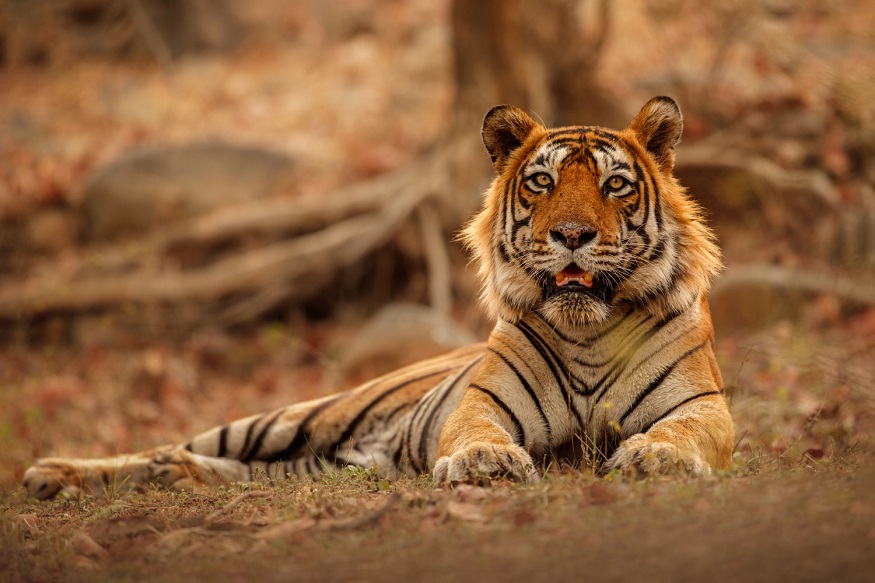In the diverse landscapes of India, from the grasslands of Assam to the forests of Madhya Pradesh, the majestic tiger holds a place of prominence as the nation’s national animal. Home to a significant portion of the world’s tiger population, India plays a pivotal role in the global efforts for the conservation of this magnificent beast, harbouring nearly 70% of the global tiger population.
The tiger is deeply woven into the Indian culture, symbolising power, courage, and grace. Its presence can be seen in various mythologies and folklore, capturing imaginations for centuries. The government and several NGOs work assiduously to protect this endangered species through initiatives like “Project Tiger”, launched in 1973 to help augment the dwindling tiger population.
Also Read: List of Desert Animals and Their Adaptations
Despite the encroachments of urbanisation and habitat loss, India’s tiger reserves have witnessed a commendable increase in tiger numbers, showcasing a beacon of hope in wildlife conservation. The reserves, including renowned ones like Bandipur, Sunderbans, and Sariska, provide a vital sanctuary for tigers, safeguarding them from poaching and helping maintain the delicate ecological balance necessary for their survival.
India’s endeavours to preserve the royal Bengal tiger underscore a committed movement towards biodiversity and echo a deep respect for the wildlife that is an integral part of the nation’s rich heritage. The journey of the Indian tiger from the brink of extinction towards a more hopeful future is a testimony to India’s sustained conservation efforts, kindled by a profound reverence for this majestic animal.
Tigers are fascinating creatures with many incredible attributes, and learning about them can be a great way to foster a love for animals and nature in children. Here are some interesting facts about tigers for children:
Big Cats: Tigers are the biggest members of the big cat family, which also includes lions, leopards, and cheetahs.
Stripes: Each tiger has a unique set of stripes, just like humans have individual fingerprints. Their stripes are not only on their fur but on their skin as well!
Swimmers: Unlike many other big cats, tigers love water! They are excellent swimmers and often soak in waterholes to cool down.
Vision: Tigers have fantastic night vision. In fact, they can see six times better in the dark compared to humans.
Roaring: Tigers have a mighty roar. They can roar so loudly that it can be heard up to 3 kilometres away!
Solitary Animals: Tigers prefer to live alone and have large territories that they mark with their scent to keep other tigers away.
Baby Tigers: Baby tigers are called cubs. They are born blind and rely on their mother for the first few months of their life.
Camouflage: Tigers have a bright orange coat with black stripes that help them blend in with the tall grasses where they live, a perfect camouflage for stalking their prey.
Diet: Tigers are carnivores, which means they eat other animals. They are known to consume various animals, including deer, wild boar, and sometimes even birds.
Endangered: Sadly, tigers are endangered, with only a few thousand left in the wild. Many people around the world are working hard to protect them and their homes.
Super Senses: Tigers have excellent senses of hearing and smell, which help them hunt very efficiently, even in the dark!
Chuffing: Tigers have a special friendly way of saying hello called “chuffing,” which sounds like a sneeze and is used to express happiness.
Powerful Legs: Tigers have very strong and powerful legs. They can jump as far as 10 metres in one leap — that’s longer than a bus!
Different Species: There are several different species of tigers, including Bengal tigers, Siberian tigers, and Sumatran tigers, each living in different parts of the world.
White Tigers: Some tigers have white fur with black stripes instead of the usual orange with black stripes. These are known as white tigers, and they have blue eyes.
Teeth: Tigers have 30 teeth in their mouth, and their canines are the largest among all big cat species, reaching up to 3 inches (7.5 cm) in length.
Fast Runners: Tigers are incredibly fast and can run up to speeds of 65 kilometres per hour (40 miles per hour) for short bursts when they are hunting.
Big Appetites: Tigers can eat a lot in one go. During a meal, a tiger can eat up to 90 pounds (40 kilograms) of meat!
Climbing Cubs: Tiger cubs learn to climb trees at a very young age to keep safe from predators, but as they grow bigger and heavier, climbing becomes quite a tough job for them.
Communication: Tigers communicate using different sounds, including roars, grunts, and hisses. They also use body language to communicate with each other.
Also Read: Animals and Their Homes
Where can you see tigers in india
India is home to a significant portion of the world’s tiger population and is a fantastic place to observe these magnificent creatures in their natural habitat. There are numerous tiger reserves and national parks across the country that facilitate tiger-spotting. Here are a few of the best places to see tigers in India:
Ranthambore National Park, Rajasthan: This is one of the most popular parks for tiger viewing in India. Known for its high density of tigers, Ranthambore offers excellent opportunities for photography amidst ruins of old forts and lakes.
Bandhavgarh National Park, Madhya Pradesh: Bandhavgarh has one of the highest densities of Bengal tigers in the world. The park also offers elephant-back tiger safaris, adding an extra layer of excitement to the experience.
Sundarbans National Park, West Bengal: The Sundarbans, a UNESCO World Heritage Site, is a vast mangrove forest and is home to the famous Royal Bengal Tigers. The tigers here are unique due to their reputation as man-eaters and swimmers.
Kanha National Park, Madhya Pradesh: This park inspired Rudyard Kipling’s ‘The Jungle Book’ and it’s one of the best places in India to spot tigers. It’s also dedicated to saving the Barasingha from extinction.
Corbett National Park, Uttarakhand: India’s first national park, Corbett offers a good chance of spotting tigers in addition to its stunning landscapes and diverse wildlife.
Tadoba Andhari Tiger Reserve, Maharashtra: This is Maharashtra’s oldest national park and is an excellent place to spot tigers. You might also see other animals like leopards, sloth bears, and wild dogs.
Pench National Park, Madhya Pradesh and Maharashtra: This park straddles two states and was the setting for the original ‘Jungle Book’. It’s another great place for tiger spotting in India.
Nagarhole National Park, Karnataka: Part of the Nilgiri Biosphere Reserve, Nagarhole has a healthy tiger population and the park’s Kabini River attracts a variety of wildlife.
Also Read: Educational Field Trips for Students: Definition and Benefits
Tiger sightings are often a matter of luck and patience, but visiting these parks will give you the best chances. Additionally, the best time to visit for tiger spotting is typically during the summer months when the weather is hot and dry, as tigers often come out to water sources
EuroSchool is committed to conservation and sustainability. We believe that it is important to protect the environment and the animals that live in it.










